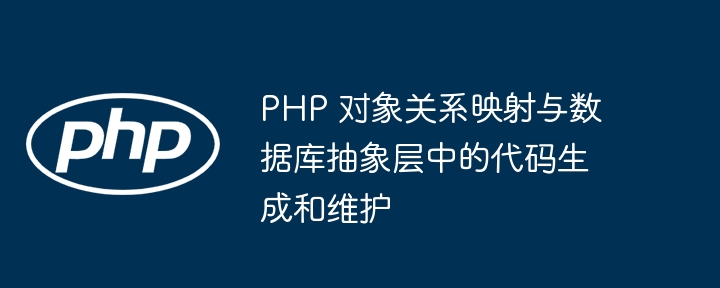Home >Backend Development >PHP Tutorial >Code generation and maintenance in PHP object-relational mapping and database abstraction layers
Code generation and maintenance in PHP object-relational mapping and database abstraction layers
- 王林Original
- 2024-05-06 14:03:021226browse
ORM and DAL tools provide code generation capabilities for creating entity classes, repositories, and other code artifacts to simplify database interactions. ORM tools (such as Doctrine, Eloquent) provide code generators for automatically generating entity classes. DAL libraries such as DBAL provide custom code generation for generating specific code based on the database schema. To maintain generated code, ORM tools provide the ability to update the schema to synchronize code and database schema changes.

Code generation and maintenance in PHP ORM and DAL
Introduction
Object-relational mapping (ORM) tools and database abstraction layers ( DAL) library greatly simplifies interaction with databases. However, in order to maintain these code bases, there is an ongoing challenge that needs to be addressed, namely code generation and maintenance.
Code generation
Use ORM tools for code generation
ORM tools (such as Doctrine, Eloquent) can automatically generate entity classes, repositories, and other code artifacts through code generators . This saves a lot of manual work, especially when dealing with large database schemas. For example, in Doctrine, you can use the following command:
./vendor/bin/doctrine orm:generate-entities App/Entity
Using DAL libraries for custom code generation
Some DAL libraries include custom code generation capabilities that allow the generation of specific code for a specific database implementation. code. For example, the DBAL (Database Abstraction Layer) library contains a code generator for generating PDO code based on the database schema:
$conn->getConfiguration()->setSQLLogger(new SqliteDbalLog());
Code maintenance
Keep generated code in sync with the database schema
As the database schema changes, the generated code must be updated accordingly. For this purpose, ORM tools often provide Update mode functionality, such as:
./vendor/bin/doctrine orm:schema-tool:update --force
Manage manually written code
In addition to generated code, there may also be manual Written code, such as custom queries, stored procedures, or stored functions. It is crucial to keep these codes in sync with the database schema, which can be achieved by manually updating them when the schema changes.
Practical case
Use Doctrine to generate code
use Doctrine\ORM\Tools\Setup;
use Doctrine\ORM\EntityManager;
// 创建元数据配置
$isDevMode = true;
$metadataConfig = Setup::createAnnotationMetadataConfiguration([__DIR__ . "/src"], $isDevMode);
// 创建 entityManager
$entityManager = EntityManager::create(['driver' => 'pdo_sqlite', 'path' => __DIR__ . '/db.sqlite'], $metadataConfig);
// 保存用户
$user = new User();
$user->setUsername('admin');
$user->setPassword('secret');
$entityManager->persist($user);
$entityManager->flush();Use PDO to generate custom code
use PDO;
// 连接到数据库
$pdo = new PDO('sqlite:./db.sqlite');
// 准备并执行查询
$sql = "SELECT * FROM users WHERE username = :username";
$stmt = $pdo->prepare($sql);
$stmt->execute([':username' => 'admin']);
// 获取结果
$result = $stmt->fetch(PDO::FETCH_ASSOC);
// 填充实体
$user = new User();
$user->setUsername($result['username']);
$user->setPassword($result['password']);Summary
Through automated code generation and Implementing a proper maintenance strategy can effectively manage the code in the ORM and DAL. This reduces manual work, improves code quality, and ensures that the code base is in sync with the database schema.
The above is the detailed content of Code generation and maintenance in PHP object-relational mapping and database abstraction layers. For more information, please follow other related articles on the PHP Chinese website!

